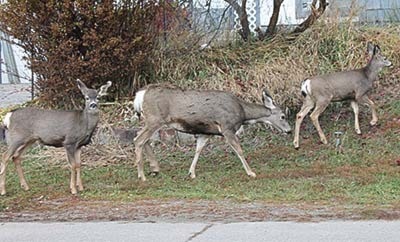Deer are wildlife. WildSafeBC’s objective is to ‘keep wildlife wild and communities safe.’
Wildlife managers are strongly against feeding, or providing safe haven for deer. They are adamant that folks do not set out salt blocks, hay, or supply vegetation for them to forage. It is a Bylaw infraction in the Town of Princeton to feed deer. Hopefully, this type of Bylaw will be expanded to outlying areas and other municipalities in the Okanagan-Similkameen.
History shows us when wild stocks mingle with domestic stock and humans, things can go awry. For example, if domestic sheep touch noses to wild sheep they can transmit a fatal pneumonia type disease to the wild stock.
Deer can inadvertently transmit Lyme disease to pets and humans. The disease is transmitted by a tick, often referred to as a ‘deer tick’. If Lyme disease carrying ticks are carried into our gardens and yards by browsing deer, they can be picked up by passing humans and pets. For more information see http://canlyme.com/ .
Increased aggression is being reported in areas where populations of habituated deer are expanding; attacks on pets to threatening humans. In spring and during fall rut, deer are more assertive, and territorially protective. If deer have been ‘raised’ in your backyard or neighbourhood, it understandably thinks it is their range to protect. Deer that are not a problem in your yard may be a problem, nuisance, or danger to your neighbours and their children.
Deer have survived in the wilds for thousands of years, and can thrive without human intervention. They are resourceful. They have adapted to human environments, taking full advantage of the opportunities that exist in urban areas. We too must be resourceful, to develop strategies to share the ecosystem while encouraging deer to move through and not loiter in our neighbourhoods.
Some excerpts for this series were taken from: Deerproofing Your Yard and Garden, Rhonda Hart 2005
For more information on Living with Wildlife visit the RDOS web site. www.rdos.bc.ca or at WildSafeBC www.wildsafebc.com
